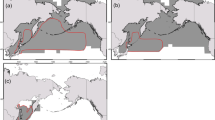Synopsis
Declared the most compact and powerful storm known to have reached the Hawaiian Archipelago, Hurricane Iniki destroyed terrestrial and freshwater habitats island-wide when it struck Kaua'i late on the afternoon of Friday, 11 September 1992. Five weeks after the storm, a research group began underwater studies on the north shore of Kaua'i to assess the physical and biological effects of the hurricane and to track at four-month intervals the recovery of three high quality streams that are home to Hawaii's native and mostly endemic freshwater fishes, mollusks, and crustaceans. Early in the investigation, information on the social behavior of resident fishes showed particular promise for assessing the impact of the hurricane and for tracing the recovery of stream ecosystems. In Hanakapi'ai Stream, the stream damaged most by the hurricane and a subsequent flash flood, two downstream species,Eleotris sandwicensis andStenogobius hawaiiensis, were missing, and members of a third one,Sicyopterus stimpsoni, were sufficiently crowded into the lower section of the stream that aggressive behavior, occasionally resulting in injury, sharply curtailed feeding and prevented all but the earliest phases of courtship. Although the study began in the middle of the spawning season forAwaous guamensis, the few males found were in poor condition and showed neither territorial behavior in response to other males nor courtship when gravid females were encountered. Farther upstream, males ofLentipes concolor directed an inordinate amount of effort toward maintaining territories. Similar, but less dramatic alterations in distribution and behavior were seen in fishes from the less damaged Wainiha River. In Nu'alolo Stream, protected from hurricane winds by nearly vertical valley walls, the behavior was typical for fishes throughout its length except forE. sandwicensis in the damaged section at the stream mouth. Most progress in the return to social behaviors characteristic of pre-hurricane conditions for fishes in Hanakapi'ai Stream and Wainiha River occurred during the first four months of the study, but it was not until October 1993, more than a year after Iniki, that the behavior of the fishes signaled a return to conditions that existed before the storm. The study demonstrated that Hawaii's stream fishes are remarkably capable of rebounding from the effects of hurricanes because of the hardiness of adults and the recruitment of young animals from the ocean as a natural part of each species' amphidromous life cycle.
Similar content being viewed by others
References cited
Fitzsimons, J.M. & R.T. Nishimoto. 1990. Territories and site tenacity in males of the Hawaiian stream gobyLentipes concolor (Pisces: Gobiidae). Ichthyol. Explor. Freshwaters 1: 185–189.
Fitzsimons, J.M., R.M. Zink & R.T. Nishimoto. 1990. Genetic variation in the Hawaiian stream goby,Lentipes concolor. Biochem. System. Ecol. 18: 81–83.
Fitzsimons, J.M., R.T. Nishimoto & A.R. Yuen. 1993. Courtship and territorial behavior in the native Hawaiian stream goby,Sicyoptertus stimpsoni. Ichthyol. Explor. Freshwaters. 4: 1–10.
Ha, P.Y. 1991. Biology of a Hawaiian freshwater goby (‘O’opu nakea),Awaous stamineus, in rivers on Kauai, Hawaii. Pac. Sci. 45: 104.
Kido M.H., P. Ha & R.A. Kinzie III. 1993. Insect introductions and diet changes in an endemic Hawaiian amphidromous goby,Awaous stamineus (Pisces: Gobiidae). Pac. Sci. 47: 43–50.
Maciolek, J.A. 1977. Taxonomic status of HawaiianLentipes, a diadromous goby, with notes on its biology and distribution. Pac. Sci. 31: 355–362.
Nishimoto, R.T. & J.M. Fitzsimons. 1986. Courtship, territoriality, and coloration in the endemic Hawaiian freshwater goby,Lentipes concolor. pp. 811–817. In: T. Uyeno, R. Arai, T. Taniuchi & K. Matsuura (ed.) Indo-Pacific Fish Biology: Proceedings of the Second International Conference on Indo-Pacific Fishes, Ichthyological Society of Japan, Tokyo.
Radtke, R.L., R.A. Kinzie III & S.D. Folsom. 1988. Age at recruitment of Hawaiian freshwater gobes. Env. Biol. Fish. 23: 205–213.
Tate, D.C., J.M. Fitzsimons & R.P. Cody. 1992. Hawaiian freshwater fishes (Osteichthyes, Gobioidei): field key to the species of larvae and postlarvae during recruitment into fresh waters. Occ. Pap. Mus. Nat. Sci., Louisiana State Univ. 65: 1–10.
Author information
Authors and Affiliations
Rights and permissions
About this article
Cite this article
Fitzsimons, J.M., Nishimoto, R.T. Use of fish behavior in assessing the effects of Hurricane Iniki on the Hawaiian island of Kaua'i. Environ Biol Fish 43, 39–50 (1995). https://doi.org/10.1007/BF00001816
Received:
Accepted:
Issue Date:
DOI: https://doi.org/10.1007/BF00001816




